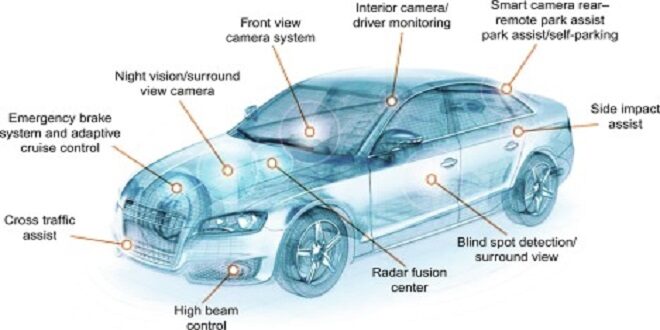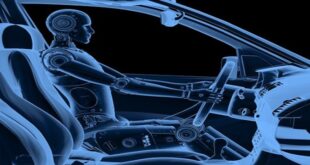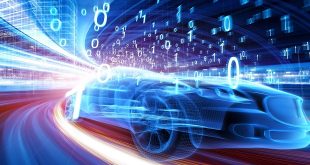Automotive Fundamentals
Picture yourself in the not-too-distant future driving your new car along a rural interstate highway on a business trip. The cruise control is maintaining the speed at a steady 100 km/hr (62 mph) and there is relatively little traffic. As you approach a slower car, the speed-control system slows your car to match the speed of the slower car and maintain a safe distance of about 53 m (165 ft) behind the slowe/r car. When oncoming traffic clears, you enter the passing lane and your car automatically increases speed as you pass the slower car. You press a button on the steering column and an image of a road map appears faintly visible (so as not to obscure the road ahead) on the windshield in front of you.
This map shows your present position and the position of the destination city. The distance to your destination and the approximate arrival time are displayed on the digital instrument cluster. You are talking on your cellular phone to your office about some changes in a contract that you hope to negotiate. After the instructions for the contract changes are completed, a printer in your car generates a copy of the latest contract version.
The onboard entertainment system is playing music for you at a comfortable level relative to the low-level wind and road noise in the car. After completing your phone conversation, you press another button on the steering wheel and the music is replaced by a recorded lesson in French verb conjugation, which you have been studying. Suddenly, the French lesson is interrupted by a message delivered in natural-sounding synthesized speech.
You have fuel remaining for another 50 miles at the present speed. Your destination is 23 miles away. Recommend refueling after exiting the highway. There is a station that accepts your electronic credit near the exit (you know, of course, that the electronic credit is activated by inserting the fuel nozzle into the car). Also, the left rear tire pressure is low and the engine control system reports that the mass air flow sensor is intermittently malfunctioning and should be serviced soon.’’ After this message has been delivered, the French lesson returns.
As you approach the city limits, the car speed is automatically reduced to the legal limit of 55 mph. The voice message system speaks again: “Leave the highway at exit 203, which is one-half mile away. Proceed along Austin Road to the second intersection, which is Meyer Road. Turn right and proceed 0.1 mile. Your destination is on the right-hand side of the road. Don’t forget to refuel.’’ This scenario is not as farfetched as it sounds.
All of the events described are technically possible. Some have even been tested experimentally. The electronic technology required to develop a car with the features described exists today. The actual implementation of such electronic features will depend on the cost of the equipment and the market acceptance of the features.A short time later, the French lesson is again interrupted by the electronic voice message system:
Replace the disk in the Navigation CD player with disk number 37 for detailed map and instructions to your destination, please.’’ Then the French lesson returns. You insert the correct disk in the Navigation CD player as requested and the map display on the windshield changes. The new display shows a detailed map of your present position and the route to your destination.
USE OF ELECTRONICS IN THE AUTOMOBILE
Electronics have been relatively slow in coming to the automobile primarily because of the relationship between the added cost and the benefits. Historically, the first electronics (other than radio) were introduced into the commercial automobile during the late 1950s and early 1960s. However, these features were not well received by customers, so they were discontinued from production automobiles
Two major events occurred during the 1970s that started the trend toward the use of modern electronics in the automobile: (1) the introduction of government regulations for exhaust emissions and fuel economy, which required better control of the engine than was possible with the methods being used; and (2) the development of relatively low cost per function solid-state digital electronics that could be used for engine control
AI is one of the biggest tech news. We are still only in the early days of the development of AI. As the technology becomes more sophisticated, it will be applied to further develop tech-based tools, such as training machines to recognize patterns, and then act upon what it has detected. It can develop your best business times idea and you can succeed in your life goal.
 Jobsearchdone.com Top News Share Website
Jobsearchdone.com Top News Share Website




